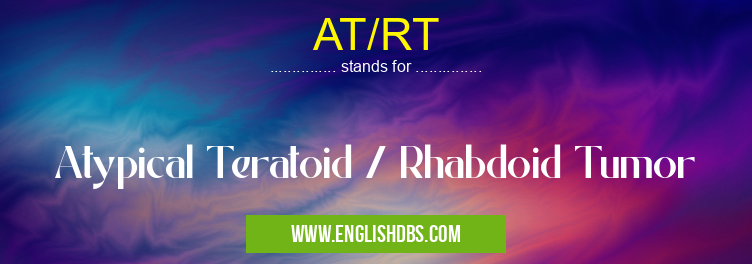What does AT/RT mean in ONCOLOGY
Atypical teratoid/rhabdoid tumor (AT/RT) is a rare malignant brain or spinal tumor primarily found in young children. It is considered one of the most aggressive pediatric brain tumors, with poor prognosis. AT/RT was first identified as a distinct entity in 1989 and has since been classified as sarcoma by the World Health Organization. AT/RT is predominantly seen in children between 0-3 years old; however, 15% of cases are seen in children over the age of three.

AT/RT meaning in Oncology in Medical
AT/RT mostly used in an acronym Oncology in Category Medical that means Atypical Teratoid / Rhabdoid Tumor
Shorthand: AT/RT,
Full Form: Atypical Teratoid / Rhabdoid Tumor
For more information of "Atypical Teratoid / Rhabdoid Tumor", see the section below.
Defining AT/RT
Atypical teratoid/rhabdoid tumor (AT/RT) is a type of very aggressive and fast-growing cancer that develops in the brain or spinal cord. The majority of these tumors are located on the back part of the brain called the cerebellum or within its surrounding area, specifically within parts of the skull and spine known as ventricles and cisterns. In some cases, AT/RT can spread beyond these areas, making treatment and recovery more challenging. The word "teratoid" means "resembling a monster," referring to how cells affected by this tumor may look under a microscope--abnormal and "monstrous" in appearance compared to normal cells. The word "rhabdoid" comes from a type of cell typically seen within kidney cancer known as rhabdoid cells. As such, these tumors have characteristics similar to both types of cells and contain genetic mutations associated with both types of cancers.
Causes & Treatment Options
The exact cause of Atypical Teratoid / Rhabdoid Tumor remains unclear; however, it appears to be due to random changes occurring inside certain genes during early prenatal development which then lead to uncontrolled growths forming inside affected brain areas later on during childhood years. While some cases may respond positively to certain treatments such as chemotherapy and radiation therapy, others may need more aggressive interventions including surgery or total removal if prolonging life expectancy makes sense for affected individuals after discussing various risks with their healthcare team(s).
Essential Questions and Answers on Atypical Teratoid / Rhabdoid Tumor in "MEDICAL»ONCOLOGY"
What is an Atypical Teratoid/Rhabdoid Tumor (AT/RT)?
AT/RT is a rare, aggressive type of cancer that occurs mainly in young children. It typically affects the central nervous system, but can also spread to other organs. This type of tumor is usually treated with surgery, radiation therapy and chemotherapy.
Who gets AT/RT?
AT/RT is most commonly diagnosed in children younger than three years old, though it can affect people of any age. It is more common in males than females and is more likely to be found in Caucasian children compared to African-American or Hispanic children.
What are the signs and symptoms of AT/RT?
Symptoms vary depending on the location of the tumor within the body. Common signs may include headaches, vomiting, seizures, changes in behavior or development, difficulty speaking and movement problems.
How is AT/RT diagnosed?
To diagnose AT/RT, doctors will typically order imaging tests such as an MRI or CT scan to help identify any suspicious areas in the brain or elsewhere in the body. A biopsy may then be performed on these areas to confirm a diagnosis.
What treatments are available for AT/RT?
Treatment will depend on several factors including the size and location of the tumor as well as your child’s age and overall health condition. Surgery followed by chemotherapy and radiation therapy may be recommended for some cases. In some cases clinical trials may be appropriate if traditional treatments aren’t effective.
Is there any hope for those with AT/RT?
There has been progress made over recent decades when it comes to treating this really rare cancer with better outcomes achieved from advances made in medical science specifically related to treatment therapies such as surgery, chemotherapy and radiation therapy. Many patients have responded positively to these treatments leading to successful remission outcomes for some individuals.
What followup care should I expect after treatment for AT/RT?
After treatment for AT/RT is complete, it is important to receive regular follow up care from your doctor which includes check ups on a regular basis (every 3-6 months) depending on the individual circumstances along with blood tests and other scans so that any recurrence can be detected early if necessary.
Final Words:
Atypical Teratoid / Rhabdoid Tumor (AT/RT) is one among many types of rare malignant tumors that primarily occur in young children between 0-3 years old but can also affect older children as well in some cases. It is an aggressive form of cancer that typically affects the cerebellum region within parts of the skull and spine such as ventricles and cisterns that can also spread outside these areas depending on each case's individual circumstances and prognosis. While medical science does not yet know what exactly causes this condition, it has identified several treatments for it ranging from chemotherapy to full surgical removal depending on each individual case's specifics while taking into consideration risks involved too before any decisions can be made regarding treatment protocols for those diagnosed with AT/RT.
